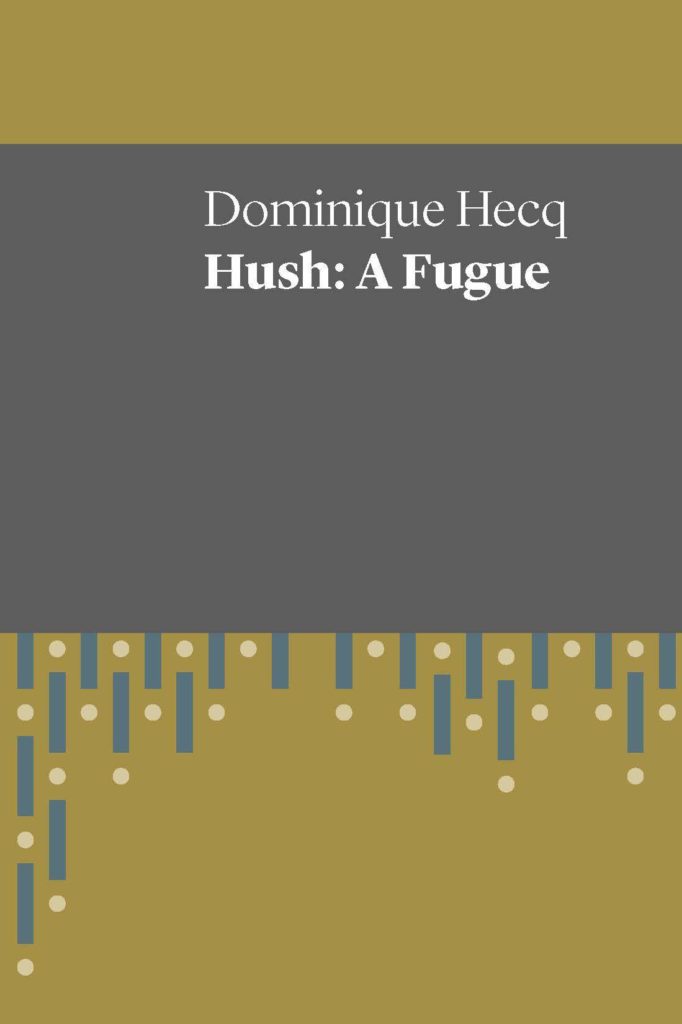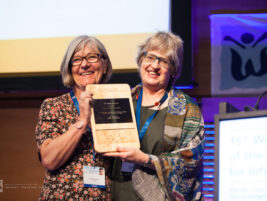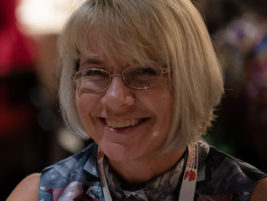Photo reference: The book cover; sourced from UWA publishing: https://uwap.uwa.edu.au/products/hush-a-fugue
Reviewed by Christine Hill (PhD) (Australia)
Hush: A Fugue
Dominique Hecq, 2017, UWA Publishing, Crawley WA
At first glance this may look like a book about sudden infant death, but it is much more than that. The narrative is non-linear and the prose unconventional, yet like the feeling/thinking process of the therapeutic encounter, it works its way to the heart of the matter to create a space for change. This is a story of loss, love, and reparation – an old story told in a new way, and one we can learn from. Of note, all quotes from this book, in this review, are in italics.
When a baby suddenly dies the whole world feels wrong. Nature is out of order and madness is in the air. Disbelief gives way to guilt and anger, and fear. Grieving parents become incoherent and unreliable; their own relationship struggles to breathe. Siblings fear they will be next, and wonder: “Why?” and “How?” but there is no one to answer. All we know is that when a baby dies part of us goes with her, and for a time, life feels empty as the cot. Hush: A Fugue is a disquieting exploration of that emptiness.
The incidence of Sudden Infant Death Syndrome (SIDS), or cot death, has significantly reduced since the 1970s (Raven 2018, p.74) but despite substantial medical research and public health campaigns SIDS continues to be “a leading cause of post-neonatal mortality in many developed countries” (Hauck et al. 2017). However, the absence of a universal system for data-gathering means that accurate statistics are elusive. The statistical picture is blurred further by the fact that the scientific community cannot agree on a definition, with one senior researcher confessing that “it is disappointing that standard definitions of SIDS are either being ignored or idiosyncratically modified to suit researcher’s needs” (Byard 2018, p.3). However, the experts do agree on one thing: “SIDS remains a diagnosis of exclusion” (Duncan & Byard 2018, p.16), leaving families and their mental health professionals to manage the gap.
Fortunately, when facts are not enough, we have the arts to help us. The prose poetry of Hush: A Fugue confronts the gap as it exposes and explores primitive impulses, nursery ghosts, and creative reparation. Here, we find a mother who employs the act of writing to surpass her grief after the sudden death of her infant son. At first the wild pain of loss engulfs her. Unable to speak, eat, or sleep, she comes close to disappearing herself. She cooks comfort food, almost obsessively, yet it brings no comfort: “I longed for food…I would not eat…I could not eat lest I implode with guilt or explode with anger”. Consumed by the fear of “succumbing to sorrow”, she could not cry but felt compelled to write, “for the sheer satisfaction of keeping fear at bay…even if words did not make sense”. In the writing, something is unlocked. The tears come, and with them, a flicker of hope.
With time, the liveliness of her first child and the quiet presence of an imperfect husband combine to create enough space for the mother to acknowledge the continuity of life: “the sky became our calendar”. The tempo of the natural world, with its changing seasons, holds her and gives her something to hold: an experience that is real. She keeps writing. On a cliff-top, before dawn, life is again precarious. We hold our breath as she spreads her arms; in the dark we hear her primal cry, and then,
“In the darkness, there came a turning. It was as though the dark itself offered a leitmotif. At that point I saw just two qualities: an ability to be, and to be attentive…An inner world opened up in me. I began to walk and as I walked I began to speak again”.
It was, she says, a glorious dawn.
The appropriately ambiguous ‘fugue’ of the book’s title creates a link between the mother’s distorted thinking and the writing’s rhythm. By interweaving memories, hallucinations, happy-family scenes, and the loneliness of her struggle with reality, Hecq mimics the contrapuntal composition of a musical fugue, her words on the page like notes on a score. This physical arrangement of words serves to contain the terror of the mother’s dissociative fugue state enough for the reader to feel it. The form allows Hecq to find the words to say it; to find those impossible, voiceless words (Hush!), and to play with them, pull and push them to their limits, repeat them over and over and over until we know they must be true. She loses words, finds foreign ones, remembers, or shrinks from others. We come to understand that her words are her Self. They are starved, silenced, re-invented, and purposefully tossed across the page for us to swallow, digest, and make sense of. The shocking words take us with her, down, down to her “black sea”, that place “between guilt and grief”; and yet we do not drown.
We do not drown because Hecq saves us, and herself, with the art of her writing. Holding her breath, and paddling like mad, she bravely gathers those dreadful words to her breast. She looks them in the eye, considers them, and orders them to obey her, just as she was obliged to suffer the things they describe. Unflinching, she guides the reader through her dark interior, through madness and fear, to come out the other side, into the light and very much alive. This lived fugue experience and the work of its writing allow her to finally “put death to death” and create a poetic monument to her son, David.
When a baby dies there is no consolation, only mourning, but as Hecq so painfully reveals, the path from grief to mourning is not easy, especially when other griefs get in the way. She reminds us that, at first, the task is to exist, in place and time, to watch the seasons come and go, to allow for the possibility of finding words, and with them, reparation:
“I, myself, kept alive as I turned affect into feeling, feeling into emotion, memories into fiction, fiction into being in a relentless process of littering and lettering loss, hope, love.
It is a matter of existing within that polarity – between the white centre and the vast periphery, between the black in the white and the colours in the light.
To exist is to stitch a wound.
To write is nothing but to stitch a wound with a child’s hand”.
This is not a book for newly bereaved parents; although after a time, and with guidance, it may offer hope to some, particularly to those who feel trapped by their grief and are unable to mourn. But for those of us whose work is concerned with the mental health of infants and their parents this book is a gift. Until now, our understanding of SIDS has relied on scientific writings which attempt to describe and define, or on the sad recounting of personal stories. Hecq’s poetry is different; it takes us deep inside the mad-making experience of losing a child and then, courageously, generously, Hecq takes us with her as she writes her way from grief to mourning, and finally, to self-examination and understanding: “Perhaps writing, especially poetry, is the art of loss. It is the blanks that are pressing”. She shows us how art can make sense of things that make no sense.
After the death of a baby families must find ways to get on with their lives. There may be new babies – replacement babies, obliged-to-be-lively babies, filled-up-with-parental-anxiety-babies – who struggle to be in their own skin. These babies find themselves on the other side of the empty space, the space once occupied by another, the space where “the blanks […]are pressing” and where answers might lie. Sometimes that empty space is transported from a past generation where the deceased baby is consciously known to the present as no more than a ghostly whisper, if at all.
When infants appear to have difficulties with sleeping, eating, crying, or myriad other behaviours and their parents come to us for answers it is not immediately clear what (or who) is missing. However, we do know that loss, in its many forms, is not uncommon. Hush: A Fugue reminds us that the echoes of grief are always calling. It is our task to listen for them.
References
Byard, R.W. (2018) Sudden infant death syndrome: definitions. In J. Duncan & R. Byard (Eds), SIDS – Sudden infant and early childhood death: The past, the present and the future (pp.1-13). Adelaide: University of Adelaide Press. doi: https://doi.org/10.20851/sids
Duncan, J. & Byard, R.W. (2018). Sudden infant death syndrome: an overview. In J. Duncan & R.W. Byard (Eds). SIDS– Sudden infant and early childhood death: The past, the present and the future (pp.15-50). Adelaide: University of Adelaide. Press. doi: https://doi.org/10.20851/sids
Hauck, F.R., McEntire, B. L., Raven, L. K., Bates, F. L., Lyus L. A., Willet, A.M., & Blair, P.S. (2017). Research Priorities in Sudden Unexpected Infant Death: An International Consensus, Paediatrics, 140 (2), 1-10. doi: 10.1542/peds.2016-3514
Raven, L. (2018). Sudden infant death syndrome: history. In J. Duncan & R.W. Byard (Eds), SIDS – Sudden infant and early childhood death: The past, the present and the future (pp.73-84). Adelaide: University of Adelaide Press. doi: https://doi.org/10.20851/sids
Book Review – Hush: A Fugue by Dominique Hecq. Perspectives in Infant Mental Health Vol. 28 No. 1 | Spring/Summer 2020
Authors
Christine Hill (PhD) (Australia)








